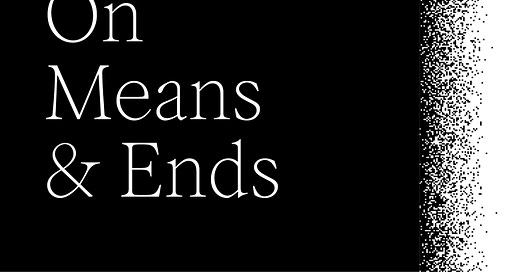On Means & Ends
An interrogation of designers’ perceived role in addressing complex systemic issues
Hello! I’m front-ending this newsletter with excerpts from a disappeared (read: peak-pandemic era) Master’s thesis. For everyone receiving this in their inbox for the first time, I’ve fleshed out the About page with what types of content to expect and why. As the Fulbright work gains momentum “at the speed of trust,” I’m revisiting my earlier inklings about the role of design—its potential and limitations—in systemic issues.
I’ve never been too concerned with what it means to make good work. Good work is straight ahead: easy to spot and fun to strive toward. But for as long as I’ve thought of myself as a designer, I have grappled with what it really means to make “work for good.”
In the beginning, it was a question of what the work was about. The album cover represents humanity’s spiritual connection to nature. The sticker indicates you voted in the election. The infographic illustrates the gender pay gap. Soon, the question expanded into who or what the work was for. The canon of graphic design reassured me that ethics were dealt with in the 1960s, when top firms signed a manifesto1 against wasting their talents on cigarette advertisement. The proceeds from every poster are donated to the animal shelter. The font is more legible to dyslexic children. The logo is designed pro-bono for the food bank. The prefab shelters are for refugees. Next came the question of where the work was from and how it was made. The purview of industrial design—material, construction, manufacture—suggested to me that ethics could be addressed through provenance, labor, and access.2 The tote bag is locally screenprinted with soy-ink on fair-trade cotton. The textile is woven at a revitalized mill that employs indigenous women. The label tells buyers how many miles the product traveled to its shelf. All these parameters remain relevant, but together they are a scatter-shot approach to fuzzy ideas of improvement. It’s not enough3 to state the intention and expend the effort, only for one thing to undermine the other. There is still a gaping chasm between most design practice and clear theories of societal change.
When I left a career in graphic design to interrogate these suspicions, I was driven by a very intense but vague inkling that I was always trying to make “work for good” without understanding or intentionally situating my designs within the systems that I knew they would inevitably occupy, reinforce, influence. At a systems level, making “work for good” is no longer a self-contained endeavor because the work aims to shift a network of complexities “towards better.” These days, I question what exactly we want to improve towards, and whether this is really the work that gets us there. What are the ends and their matching means? This is a political question and an economic question and a philosophical question before it is a design question—and that’s okay. It’s extremely exciting, because it demands a set of knowledges and contexts more diverse than the design canon alone can offer. It’s also a little bit terrifying, because this face of ethics is not appeased by a carefully curated client list. Instead, it asks: Is this work claiming to alleviate surface consequences of a broken system while entrenching its underlying conditions and components? Is it possible to subvert corrupt systems without getting your hands dirty? If the master’s tools cannot dismantle the master’s house,4 do you forgo the incremental progress of in-house infiltration? What does your ego blurt out first, and what actually shifts the system? What ratios of visionary idealism and pragmatic complicity are required for ethical and urgent change?
As I struggle with the “how,” my portfolio of “what” keeps broadening to encompass all the ways society has gone wrong in a big and tangled way.5 It’s surprisingly easy to draw the connection between my history with endangered language revitalization and my more recent work with equitable carbon sequestration and nuclear risk reduction. Language loss, environmental extraction, and social injustice follow the same patterns of proliferation; they are all symptoms of a shared systemic sickness. You could say that I’m motivated by a combined sense of urgency around ① structural inequities that disproportionately affect some, and ② existential threats that affect all. Absolutely none of this guarantees that the resulting work is “for good.”
Being urgent6 is to work as if the end justifies the means; responding to urgency instead requires recognition that the end is actively shaped by the means. This is the hard “how,” and it’s a dimension of design work that somehow still lives in the long shadow of popular discourse and pedagogy. Today’s tools, words, and ways of working as a designer make it exciting and relatively easy to address a problem like CO2 emissions while neglecting—even exacerbating—the socioeconomic conditions that have been historically overlooked in the environmentalist movement.
While techno-fixes have incredible power to divert immediate damage, they’re also disproportionately represented in a daydreaming industry that has charged itself with solving problems—always thinking outside of the box, always thinking inside the master’s house. Sustainable design might be a trending tide that lifts all boats, but there remains a strong rip current of consumer-driven market mechanisms dragging everything out to sea. Shifting current systems toward an equitable post-carbon future requires every designer—as actant7 and participant—to contend with processes, stakeholders, politics, and timelines beyond the holy grail of form and function.8 After all, climate change is a consequence of twin feedback loops: escalating greenhouse gas emissions (physical human activities) held up by inequitable, unsustainable growth paradigms (socioeconomic human constructions). The fast work of carbon removal must also be the slow work of reparations, degrowth, and redistribution. The means are bound up with the ends. We must give ourselves permission to elevate the procedural as topical, beginning to define a system-shifting framework that remembers design ethics are defined by a harmonious “what” and “how.”





